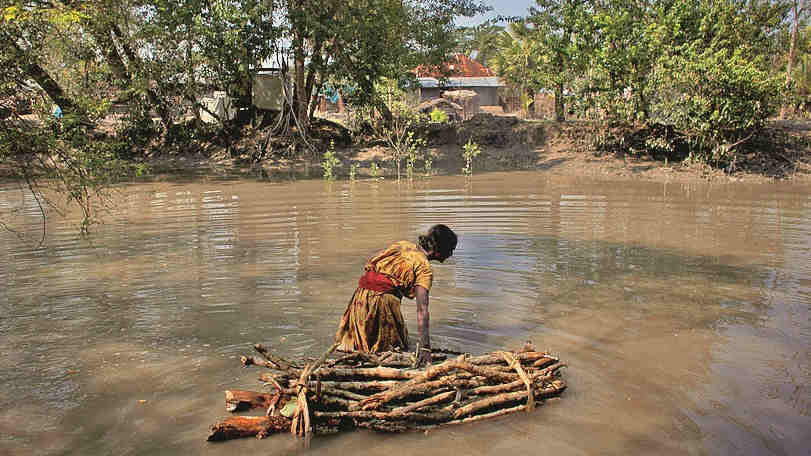
The present generation is leaving behind a broken planet: Code Red
 |
| Representational image.: Getty Images |
There are two aspects of climate change that are important to understand and keep in mind. The first is that it is part of an even bigger problem of environmental degradation and destruction. The second is that since the natural environment is a shared resource for all inhabitants of the planet, it constitutes a global problem which requires global solutions. Hence, knowing the extent of the problem and acting collectively towards a solution are of the essence. According to the Sixth Assessment Report, the carbon dioxide concentration in the atmosphere is now at the highest level in at least two million years. The sea level has been rising at the fastest rate in at least 3,000 years. The Arctic sea ice area is the lowest in at least 1,000 years. Glaciers have been retreating at an unprecedented speed not seen in at least 2,000 years. These time scales are not hyperboles; they are based on the latest scientific methods and models of estimation. It is indisputable that the activities of human beings are the root cause of extreme climate events, including heavy rainfalls, severe droughts, intense heat waves and massive wildfires. The oceans have been warming too. Since carbon dioxide is soluble in water, the seas are becoming more acidic and losing oxygen content. Clearly, not only are human beings at risk of being adversely affected, all forms of life on land, air and in the water are threatened. According to biologists, we are going through the sixth mass extinction of biological species. The point to note is that the earlier five took place before Homo sapiens ruled the earth. It is also estimated that the sixth one induced by human development is also the biggest known to biologists.
Although the problem appears to be complex and alarming, the solution, at least on paper, is patently obvious. Carbon dioxide emissions have to be reduced swiftly and decisively. Emissions have already gone beyond safety limits. However, despite many attempts at getting the global community of nations to reduce fossil-fuel use, success has not been attained. Some countries, like the rich nations, had contributed during the nineteenth and twentieth centuries large doses of carbon dioxide now hanging in the atmosphere. Relatively poorer countries, now beginning to aspire to the material development standards of Europe and North America — like China or India — are burning large amounts of fossil fuels to grow faster and attain higher material standards of living. China is the biggest polluter of carbon; India being a distant third. The second place goes to the United States of America. However, in terms of per capita emissions, the US is the largest with China a middling second (amongst these three nations) and India the last. India and China have claimed that the major burden of reduction of carbon emissions will have to be borne by the rich nations while other countries use more fossil fuels to catch up with them.
That is the position of the Global South. India’s environment minister has claimed, after the Sixth Assessment Report was published, that it vindicates India’s stand that climate change is mainly caused by the cumulative emissions of the rich nations. The minister pointed out that India’s cumulative and current emissions are low. The developed nations argue that it is the total amount of greenhouse gases in the atmosphere that matters, not per capita emissions. There is an ethical issue too. If India and China are allowed to pollute more as an opportunity to catch up, it might happen that 20 years from now some of the poorest countries of Africa start polluting much faster than they are doing now. The situation could get much worse. Would India and China then have the moral authority to request these countries to reduce pollution?
India’s real position is even more fragile than what the IPCC claims. India has comprehensive policies on paper but they are not implemented in most cases. The nation has been increasing its forest cover but decides to clear forests to mine diamonds; it has ambitious plans for expanding solar power usage but has enormously inefficient electricity infrastructure. Whatever might be the official rhetoric, when it comes to a crunch, the environment is always given short shrift when the alternative is commercial exploitation. There is a myopic vision of development, beginning with making large dams to paving wide highways; from extensive use of hydropower to mining in forest areas. Doublespeak and near-sightedness can be a lethal combination.
The Sixth Assessment Report is, arguably, one final warning about the urgency of appropriate global action. In not being able to change our lifestyles and consumption patterns, human beings will be behaving irresponsibly toward future generations, yet unborn, who cannot vote against us, or sue us in a court of law. Our generation may leave behind an environmentally broken planet for the future. If, indeed, we do so, it will not be on account of ignorance; rather it will be a matter of deliberate choice.
Anup Sinha is former professor of Economics, IIM Calcutta


0 Response to "The present generation is leaving behind a broken planet: Code Red"
Post a Comment
Disclaimer Note:
The views expressed in the articles published here are solely those of the author and do not necessarily reflect the official policy, position, or perspective of Kalimpong News or KalimNews. Kalimpong News and KalimNews disclaim all liability for the published or posted articles, news, and information and assume no responsibility for the accuracy or validity of the content.
Kalimpong News is a non-profit online news platform managed by KalimNews and operated under the Kalimpong Press Club.
Comment Policy:
We encourage respectful and constructive discussions. Please ensure decency while commenting and register with your email ID to participate.
Note: only a member of this blog may post a comment.